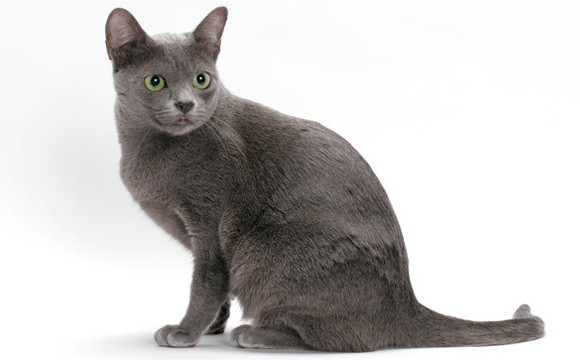History
The Korat cat, a symbol of good luck in Thailand, has a rich history dating back to the “Cat-Book Poems” (1350-1767 AD). These manuscripts describe the Korat as having green eyes and a silver-blue coat, likening it to rain clouds. Unlike the royal Siamese, Korats were treasured by commoners and often given as gifts to brides to ensure happiness. Known in Thailand as Si-Sawat, these cats were not sold but gifted as tokens of respect.
Jean Johnson is credited with introducing the Korat to the United States in 1959. After several attempts to buy Korats in Bangkok, she received a pair from the Thai government. This pair, named Nara and Darra, became the foundation of the Korat breed in the U.S. Johnson initially crossbred them with Siamese cats to avoid inbreeding but eliminated Siamese traits from her breeding program. Additional Korats were brought from Thailand in the 1960s, leading to the breed’s recognition by the American Cat Association (ACA) and the Cat Fanciers’ Association (CFA) in 1966.
Despite their rarity, Korats have a dedicated group of breeders and fanciers in the U.S. In Thailand, their numbers have dwindled, but they remain symbols of good luck, with anecdotes highlighting their continued cultural significance.
Physical Characteristics
Coat and Color:
- Korat cats have a distinctive solid silver-blue coat with no tabby markings or shading.
- The hair shafts are lighter at the roots, shading to darker blue before the tips, creating a silver-tipped “halo effect.”
- The Korat’s coat achieves its full beauty between two to four years of age.
Body Type:
- Korats possess a muscular, semi-cobby body type.
Eyes:
- Their eye color, which matures with age, is a vibrant green, often compared to the color of new rice.
Temperament and Personality
Korat cats are affectionate and intelligent, known for their strong bonds with humans. They crave interaction and can be quite playful, often engaging in fetching games. Korats are not as vocal as Siamese cats but will communicate their needs effectively. They have a rating of 8 out of 10 for activity and playfulness, indicating a lively yet not overly hyper demeanor.
Care and Maintenance
Grooming:
- Korats have minimal grooming needs due to their short coat.
- Regular brushing will help maintain the coat’s sheen.
Health:
- Generally healthy, Korats are resilient and hardy cats. However, regular vet check-ups are recommended to ensure they remain in good health.
Living Environment:
- Korats thrive in environments where they receive plenty of attention and interaction.
- They are good with children and can coexist with other pets, provided proper introductions are made.
Summary of Characteristics
| Characteristic | Rating (out of 10) |
|---|---|
| Activity | 8 |
| Playfulness | 8 |
| Need for Attention | 8 |
| Affection | 9 |
| Need to Vocalize | 5 |
| Docility | 1 |
| Intelligence | 8 |
| Independence | 3 |
| Healthiness | 6 |
| Grooming Needs | 2 |
| Good with Children | 8 |
| Good with Other Pets | 8 |
Conclusion
The Korat cat breed, with its rich history and cultural significance, is a treasured companion known for its beauty, intelligence, and affectionate nature. While they are relatively rare, their loyal and engaging personalities make them beloved pets. With proper care, Korats can thrive in various environments, bringing good luck and joy to their owners.
For more detailed information, visit the Korat Cat Breed page on Cat’s Place.

